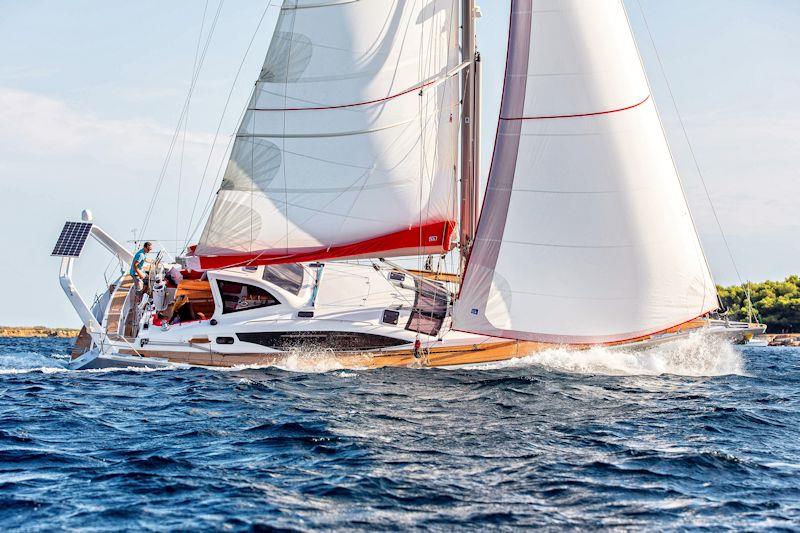
Improve Your Sailing Performance - 3 Simple, Cost-Effective Upgrades
by Phil Anniss 1 Oct 2020 17:00 UTC

Voilier Allures 52 © Alizée Palomba Photographe
At upffront.com we are passionate about performance sailing hardware and rigging. However, that doesn't mean we are all about racing. It means we believe in modern materials and technology to deliver lighter, stronger products which can benefit all types of sailing boats from club racers to the smallest coastal cruising day-boats.
Reducing weight should be every sailors goal, no matter what their sailing style. One kilogram removed from the mast and rigging package is equivalent to adding 4kg to the keel. So, reducing weight aloft increases your stability and reduces pitching / rolling which means you can sail faster in more comfort. Reducing all-up weight also lowers the overall rig loads which in turn reduces fitting fatigue, which can end up saving you money in repair and maintenance costs.
Here are three simple ways you can make a significant improvement to your sailing performance.
How many metal shackles do you have on your sailboat - 30?
An 8mm Wichard D-shackle weighs 55g which would give you a total weight of 1650g for 30 shackles. There are only a very few instances where you cannot replace a metal shackle with a Dyneema® soft shackle / loop. An equivalent soft shackle weighs approx. 3g, which would mean a total weight saving of approx. 1560g over the whole boat!
If you are still running with Piston hanks on your headsail - a simple change-out to soft hanks can make a significant difference. Over a 14m luff length you would have approx. 20 hanks. Each one will weight approx. 60g where the equivalent soft hank is again approx. 3g. This would deliver a weight saving of another 1140g, up the luff of your genoa, plus help reduce your luff sag!
How many blocks do you have on your boat!?
Let's take a standard single 40mm block as an example: the traditional style Ronstan 40mm All-purpose block (RF40100) weighs 70g. Their latest Series 40 Orbit block, on the other hand (RF45101), has a weight of just 33g - a saving of 37g per block. The RRP price of the RF45101 is 40% more than the RF40100 but provides a 54% weight saving. Let's say you have 20 blocks on your boat. You could make a 740g weight saving for an additional cost of approx. $/€150 (at current retail prices).
Taking this a little further, in many instances lash thimbles are being used in purchase systems and line leads to completely replace blocks. They are very simple, very strong, long lasting with zero maintenance required. For example, the Ronstan RF8090-08 low friction ring has a working load 3x greater than the two blocks above, weighs just 4g and costs 52% LESS than the RF40100 Utility block. Replacing 10 blocks in purchase systems with low friction rings could save you +500g
Upgrade your purchase systems
With such significant weight savings to be made by switching to low friction rings, offers the opportunity to increase your purchase systems, and save weight at the same time. If you do not have enough purchase in the system you avoid making those small adjustments that can keep you in the groove. Whether it is your mainsail outhaul, vang, genoa car track or backstay purchase, remove that 10-year-old 4:1 purchase and build a new 6 or 8:1 instead. Using Dyneema single braid and low friction rings, the raw material costs are low, its simple / fun to do and trimming becomes a pleasure rather than a chore.
Is it worth it?
The three simple improvements above can easily remove 3-4 kilos from your rig package. You may only be saving 20-30g a time, but they all add up and they can have a significant impact on your boat's performance.
To put this into context, an upffront customer was upgrading his Nitronic rod standing rigging to composite shrouds. This is not a cheap upgrade, but it is one of the single biggest and quickest savings you can make, reducing standing rigging weight by 70-80%. He had an X-37 and the overall weight saving involved was 7,5kg. Having worked on a number of larger composite rigging projects, where we were saving 10's of kilos, we were slightly nervous that the owner would not notice the 7,5kg improvement on his boat. However, he was thrilled saying that the boats performance had been "completely transformed", especially upwind in a chop.
Whether you have a dinghy, trailer sailor, club racer or an old, heavy offshore cruising boat, constant vigilance with your hardware and rigging weight can make a significant impact to your speed, overall handling and sailing comfort. Improved design, modern materials and manufacturing techniques have transformed hardware strength to weight ratios, over the last 10 years, and for just a few hundred $/€ it is possible to make a real difference.
Want to know more? If you have any questions about any hardware or rigging issues, please feel free to contact us at support@upffront.com or via the
Running rigging enquiry form / Deck Hardware Estimate